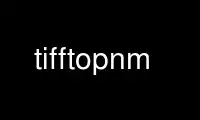
This is the command tifftopnm that can be run in the OnWorks free hosting provider using one of our multiple free online workstations such as Ubuntu Online, Fedora Online, Windows online emulator or MAC OS online emulator
PROGRAM:
NAME
tifftopnm - convert a TIFF file into a portable anymap
SYNOPSIS
tifftopnm [-alphaout={alpha-filename,-}] [-headerdump] [-respectfillorder] [tiff-filename]
You may abbreviate any option to its shortest unique prefix. You may use two hyphens
instead of one in options. You may separate an option and its value either by an equals
sign or white space.
DESCRIPTION
Reads a TIFF file as input. Produces a portable anymap as output. The type of the output
file depends on the input file - if it's black & white, generates a pbm file; if it's
grayscale, generates a pgm file; otherwise, a ppm file. The program tells you which type
it is writing.
This program cannot read every possible TIFF file -- there are myriad variations of the
TIFF format. However, it does understand monochrome and gray scale, RGB, RGBA
(red/green/blue with alpha channel), CMYK (Cyan-Magenta-Yellow-Black ink color
separation), and color palette TIFF files. An RGB file can have either single plane
(interleaved) color or multiple plane format. The program reads 1-8 and 16 bit-per-sample
input, the latter in either bigendian or littlendian encoding. Tiff directory information
may also be either bigendian or littendian.
One reason this program isn't as general as TIFF programs often are is that it does not
use the TIFFRGBAImageGet() function of the TIFF library to read TIFF files. Rather, it
uses the more primitive TIFFReadScanLine() function and decodes it itself.
There is no fundamental reason that this program could not read other kinds of TIFF files;
the existing limitations are mainly because no one has asked for more.
The PNM output has the same maxval as the Tiff input, except that if the Tiff input is
colormapped (which implies a maxval of 65535) the PNM output has a maxval of 255. Though
this may result in lost information, such input images hardly ever actually have more
color resolution than a maxval of 255 provides and people often cannot deal with PNM files
that have maxval > 255. By contrast, a non-colormapped Tiff image that doesn't need a
maxval > 255 doesn't have a maxval > 255, so when we see a non-colormapped maxval > 255,
we take it seriously and produce a matching output maxval.
The tiff-filename argument names the regular file that contains the Tiff image. If you
specify "-" or don't specify this argument, tfftopnm uses Standard Input. In either case,
the file must be seekable. That means no pipe, but any regular file is fine.
OPTIONS
-alphaout=alpha-filename
tifftopnm creates a PGM (portable graymap) file containing the alpha channel values
in the input image. If the input image doesn't contain an alpha channel, the
alpha-filename file contains all zero (transparent) alpha values. If you don't
specify -alphaout, tifftopnm does not generate an alpha file, and if the input
image has an alpha channel, tifftopnm simply discards it.
If you specify - as the filename, tifftopnm writes the alpha output to Standard
Output and discards the image.
See pnmcomp(1) for one way to use the alpha output file.
-respectfillorder
By default, tifftopnm ignores the "fillorder" tag in the TIFF input, which means it
may incorrectly interpret the image. To make it follow the spec, use this option.
For a lengthy but engaging discussion of why tifftopnm works this way and how to
use the -respectfillorder option, see the note on fillorder below.
-headerdump
Dump TIFF file information to stderr. This information may be useful in debugging
TIFF file conversion problems.
All options can be abbreviated to their shortest unique prefix.
NOTES
Fillorder
There is a piece of information in the header of a TIFF image called "fillorder." The
TIFF specification quite clearly states that this value tells the order in which bits are
arranged in a byte in the description of the image's pixels. There are two options,
assuming that the image has a format where more than one pixel can be represented by a
single byte: 1) the byte is filled from most signficant bit to least signficant bit going
left to right in the image; and 2) the opposite.
However, there is confusion in the world as to the meaning of fillorder. Evidence shows
that some people believe it has to do with byte order when a single value is represented
by two bytes.
These people cause TIFF images to be created that, while they use a MSB-to-LSB fillorder,
have a fillorder tag that says they used LSB-to-MSB. A program that properly interprets a
TIFF image will not end up with the image that the author intended in this case.
For a long time, tifftopnm did not understand fillorder itself and assumed the fillorder
was MSB-to-LSB regardless of the fillorder tag in the TIFF header. And as far as I know,
there is no legitimate reason to use a fillorder other than MSB-to-LSB. So users of
tifftopnm were happily using those TIFF images that had incorrect fillorder tags.
So that those users can continue to be happy, tifftopnm today continues to ignore the
fillorder tag unless you tell it not to. (It does, however, warn you when the fillorder
tag does not say MSB-to-LSB that the tag is being ignored).
If for some reason you have a TIFF image that actually has LSB-to-MSB fillorder, and its
fillorder tag correctly indicates that, you must use the -respectfillorder option on
tifftopnm to get proper results.
Examples of incorrect TIFF images are at ftp://weather.noaa.gov. They are apparently
created by a program called faxtotiff.
This note was written on January 1, 2002.
Use tifftopnm online using onworks.net services
